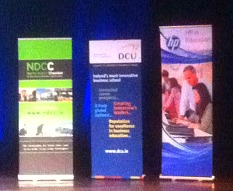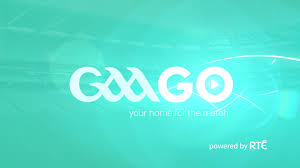Last Tuesday, (the 14th of October 2014) the 5th Get Social Mini Conference took place in The Mahony Hall of The Helix. The conference was a duration of four hours, running from 2pm until 6pm. We were fortunate enough to have a wide variety of speakers present. These included Dr. Theo Lynn, Deirdre Hogan, Jane McDaid, Lucy Campbell, Alan Coleman, Nicolas Cappiello and Eric Weaver.

Dr. Theo Lynn had the job of opening the show. No stranger to DCU as he himself is in fact a lecture at the university, and on top of that is also DCU’s digital marketing programme chairperson. He discussed the importance of social media, and how it can be an extremely powerful tool in the world of marketing. He also approached us with a question, “how do we use social media to solve problems?”. This left me somewhat puzzled. I mean, I had never actually thought of social media as a medium in which we can solve problems? I only viewed it as a means of keeping in contact with friends and family and nothing more. He really opened my eyes to how narrow minded I was being. He explained to us that by accumulating peoples search histories experts can in fact solve problems for businesses by figuring out what people want and predict future fashions and trends.

Following Dr. Theo Lynn was Deirdre Hogan, Senior Research Fellow at DCU. She was there to discuss to us what GAJO is and how it can be useful. The software itself is based on research coming from our very own labs here in DCU. It is used in order to find the correct audience on a social media site. It does this by “cutting through the noise” and using “key word targeting” in order to find the correct people to aim things at. For example, from somebody putting up a tweet or even a Facebook status saying “need a new phone”, the software would match this person up with the correct product or service, which in this case would be websites for mobile phones. Personally, I think this is an unbelievable concept. It means that you will only be presented with adds that are actually relevant to you, and not be bombarded with ones that you have no interest in whatsoever.

Third to present was Jane McDaid. She is the creative thinker for Think House who aim at connecting with 18-35 year olds. Think House have a very good relationship with a wide variety of brands, Some of which include Ben and Jerry’s and Barry’s Tea. She simplified what it takes to have “killer content” in 7 steps. She called these “the seven sins of killer content“. and they were as follows. 1: Comedy. Use this as a key way to catch peoples attention. 2: Epic, or memorable. 3: Emotive. If you can’t make them laugh try to play on their emotions. 4: WTF? Demand attention by thinking outside the box and being somewhat strange and different. In other words don’t just follow the crowd. 5: Zeitgeist. 6: NSFW (not safe for work). And lastly lucky number 7: informative. Give people the vital information, but do so in an interesting and original way. She also stressed to us the point that Dr. Theo Lynn made earlier on in the conference, that social media is an extremely powerful and influential tool, far more powerful that traditional media. I believe this is a very good point, although it’s one that a lot of people may not realize. It’s hard to come across a person in our modern society that doesn’t have at least one active social networking site. Even if you were only to use your Facebook account once a day, think of all the content that you see on it in that period of time. Think of all the status’ on your newsfeed, and not to mention the adds too. It is fair to say that the majority of us log on and check our newsfeed numerous times daily. Therefore it is fair to assume that social medial and social networking sites are hugely influential, as their content reaches millions of people on a daily basis.

According to statistics done by Twitter, there are 271 million monthly active users on Twitter, and 500 million Tweets are sent per day.
Next up was Lucy Campbell, marketing director of RTÉ Digital. She discussed us the importance of RTÉ staying “current” and innovative. Since 2003, RTÉ has been Irelands number one video on demand player, media site AND news app. They provide people with what they want. This year they launched GAAGO, a site that people can stream live GAA games from anywhere in the world. This is a great development in the world of GAA and for GAA fanatics ! I feel that is is extremely important to be innovative and provide people with new and exciting services by keeping ahead of competition.


Fifth to speak was Alan Coleman, CEO of Wolfgang Digital. He spoke about various different things. He mentioned the Google blackout 16/8/13 and how global internet searching dropped dramatically during that small period of time, by a massive 40% ! He also informed us that 1.5 million Irish people watch the Late Late Toy Show each year, but 2 million Irish people could be reached every single day using Facebook. I found this point fascinating, as I definitely thought that the annual Toy Show would reach a winder audience than Facebook. How wrong was I. He also discussed to us the “Google effect”. This is answering questions that people are asking Google in order to reach the correct target audience.

From Linkedin we had EMEA Sales Director, Nicolas Cappiello present at the mini conference. He informed us that Linkedin users now of days are now creating six times more content on their profiles than they were only two short years ago! He explained to us how users of the site can present “two different personas“: their social side and their professional side. The content comes from our own peers, inspirational leaders from all over the world, the news, and lastly from companies. Linkedin have even teamed up with 300 people worldwide to share their experiences on their own personal profiles, one of which includes American President Barack Obama. I think this is a good way to go to in order to reach out to people and inspire them, as these influential figures are ones in which a wide majority of people admire, idolize and aspire to be like.

Eric Weaver had the job of closing the conference, and what a job he did ! He is Chief Social Officer, G-14 Region, for Mediabrands Worldwide and it was actually his 4th time speaking at a Get Social conference, so he was no stranger to Ireland at this stage! Like many of the previous speakers, he talked to us about the importance of social media, and how it is a vital source of “free advertising“. I have to say, him referring to social networking sites as “free advertising” really struck home for me. I mean he was spot on. When you think about it, if you can start up a dialogue and get people talking about your product or brand online, be it through sharing a status or tweeting about it, that is essentially FREE advertising for you. With 2 million users on Facebook alone every single day, it is not only a free source of advertising, but it is also the most effective form available. He demonstrated this point to by using Oreo as an example. To celebrate their 100th birthday they decided to do a daily twist challenge. This was to have a different piece of content every day for 100 days. It was ultimately “100 pieces of content in 100 days“. They used various different social platforms to display their challenge, these included Facebook, Twitter and Instagram. By the end of the 100 days they has increased by an amazing 280% in Facebook likes alone.

From the conference I not only learned a lot, but I came away a couple of very useful statistics. I am also a lot wiser on the influence that social media has on the world today, and have a new appreciation for the power of advertising on social networking sites.